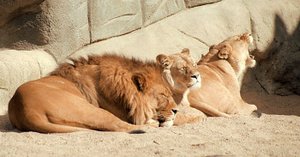The brain regulates endothermic and circulatory systems, including a four-chambered heart. Mammals encompass some 5500 species, distributed in about 1200 genera, 152 families and up to 46 orders, though this varies depending on the classification scheme adopted.
Phylogenetically, Mammalia is defined as all of the descendants of the last common ancestor of monotremes (e.g., echidnas) and therian mammals (placentals and marsupials).
Characteristics
While most mammals give birth to live young, there are a few mammals (the monotremes) that lay eggs. Live birth also occurs in a variety of non-mammalian species, such as guppies and hammerhead sharks; thus it is not a distinguishing characteristic of mammals. Although all mammals are endothermic, so are birds and so this is also not a main defining feature.
While monotremes do not have nipples, they do have mammary glands, meaning that they meet all conditions for inclusion in the class Mammalia. It should be noted that the current trend in taxonomy is to emphasize common ancestry; the diagnostic characteristics are useful for identifying this ancestry, but if, for example, a cetacean were found that had no hair at all, it would still be classified as a mammal.
Mammals have three bones in each ear and one (the dentary) on each side of the lower jaw; all other vertebrates with ears have one bone (the stapes) in the ear and at least three on each side of the jaw. A group of therapsids called cynodonts had three bones in the jaw, but the main jaw joint was the dentary and the other bones conducted sound. The extra jaw bones of other vertebrates are thought to be homologous with the malleus and incus of the mammal ear.
All mammalian brains possess a neocortex. This brain region is unique to mammals.
Mammals have integumentary systems made up of three layers: the outermost epidermis, the dermis, and the hypodermis.
The epidermis is typically ten to thirty cells thick, its main function being to provide a waterproof layer. Its outermost cells are constantly lost; its bottommost cells are constantly dividing and pushing upward. The middle layer, the dermis, is fifteen to forty times thicker than the epidermis. The dermis is made up of many components such as bony structures and blood vessels. The hypodermis is made up of adipose tissue. Its job is to store lipids, and to provide cushioning and insulation. The thickness of this layer varies widely from species to species.
Most mammals are terrestrial, but a number are aquatic, including sirenia (manatees and dugongs) and the cetaceans (dolphins and whales). Whales are the largest of all animals. There are semi-aquatic species such as seals which come to land to breed but spend the majority of the time in water.
True flight has evolved only once in mammals, the bats; mammals such as flying squirrels and flying lemurs are actually gliding animals.
No mammals have hair naturally blue or green in colour. Some cetaceans, along with the mandrills appear to have shades of blue skin. Many mammals are indicated as having blue hair or fur, but in all cases, it will be found to be a shade of grey. The two-toed sloth can seem to have green fur, however, this colour is caused by algae growths.
Origins
Mammals belong among the amniotes, and in particular to a group called the synapsids, distinguished by the shape of their skulls, in particular the presence of a single hole where jaw muscles attach, called temporal fenestra. In comparison, dinosaurs, birds, and most reptiles are diapsids, with two temporal fenestrae; and turtles, with no temporal fenestra, are anapsids.
From synapsids came the first mammal precursors, therapsids, and more specifically the eucynodonts, 220 million years ago (mya) during the Triassic period.
Pre-mammalian ears began evolving in the late Permian to early Triassic to their current state, as three tiny bones (incus, malleus, and stapes) inside the skull; accompanied by the transformation of the lower jaw into a single bone. Other animals, including reptiles and pre-mammalian synapsids and therapsids, have several bones in the lower jaw, some of which are used for hearing; and a single ear-bone in the skull, the stapes. This transition is evidence of mammalian evolution from reptilian beginnings: from a single ear bone, and several lower jaw bones (for example the sailback pelycosaur, Dimetrodon) to progressively smaller "hearing jaw bones" (for example the cynodont, Probainognathus), and finally (possibly with Morganucodon, but definitely with Hadrocodium), true mammals with three ear bones in the skull and a single lower jaw bone. Hence pelycosaurs and cynodonts are sometimes called "mammal-like reptiles", though this is strictly incorrect since in modern parlance these two are not reptiles, but rather synapsids.
During the Mesozoic Period mammals diversified into four main groups: multituberculates, monotremes, marsupials, and placentals. Multituberculates went extinct during the Oligocene, about 30 million years ago, but the three other mammal groups are all represented today. Most early mammals remained small and shrew-like throughout the Mesozoic, but rapidly developed into larger more diverse forms following the Cretaceous-Tertiary extinction event 65 mya.
The names "Prototheria", "Metatheria" and "Eutheria" expressed the theory that Placentalia were descendants of Marsupialia, which were in turn descendants of Monotremata, but this theory has been refuted. However, Eutheria and Metatheria are often used in paleontology, especially with regards to mammals of the Mesozoic.
Mammal evolutionary progression is below:
- Jawless fish: Cambrian period to mid Ordovician periods
- Bony fish: mid-Ordovician period to late Devonian period
- Amphibians: late Devonian period to early Carboniferous period
- Reptiles: late Carboniferous period
- Pelycosaurs (synapsids, or "mammal-like reptiles"): late Carboniferous period to very early Triassic period
- Cynodonts: Permian-Triassic
- Mammals: mid-Triassic period to today
Read more at Wikipedia.org



